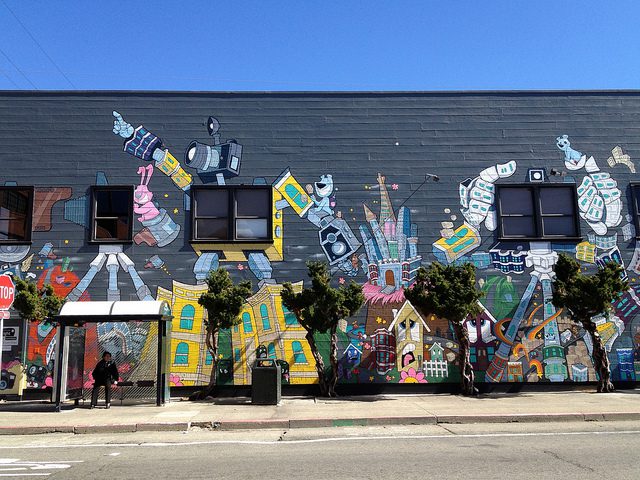
Photo by Lynn Friedman via flickr, CC BY-NC-ND 2.0
Quote of the Week:
“Initiatives that aim to address geographically concentrated poverty often focus on providing affordable housing. While such housing projects may increase quality of life for residents, they are unlikely to reduce the concentration of poverty in particular areas. New research suggests that a more effective approach to changing the geography of poverty requires the expansion of effective public transportation systems. For those who depend on public transit to commute to work, the proximity of bus stops and train stations can make the difference between a community that is affordable to live in and one that is not.”
—”How Public Bus Routes Can Deconcentrate Poverty and Promote Equity,” Chicago Policy Review
When general audience publications like Vox start getting into detailed wonky discussions of different meanings of affordable housing, you know the housing crisis has hit the mainstream. That’s a good thing, even if we think Rick Jacobus explains it better.

Downtown Newark, New Jersey. Photo by Doug Kerr via flickr, CC BY-SA 2.0
Richard Florida has suggested that all the finalists for Amazon’s second headquarters make a pact not to offer the giant online retailer incentives. This seems like a good idea to us, given the research showing that companies generally make their (re)location decisions based on other factors, but pretend not to know that they are going to score welfare from public coffers. In fact, the potential host communities, especially the ones with already expensive housing markets, should probably be asking Amazon what it will be offering to ameliorate its likely effect on their city’s housing affordability and accessibility.
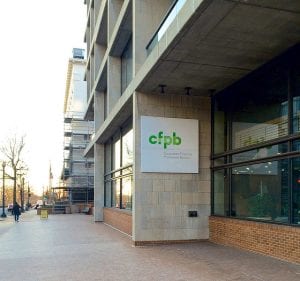
CFPB office exterior, Washington, D.C. Photo by Ted Eytan via flickr, CC BY-SA 2.0
Though Interim Head of the Consumer Financial Protection Bureau (CFPB) Mick Mulvaney may only lead the agency temporarily, he has not let that stop him from slowing down the implementation of new rules, delaying implementation of rules that were slated to take effect, and changing the agency’s mission statement to include language about deregulation. This may sound somewhat scary to those working to protect consumers—especially low-income consumers—from predatory lending and other credit traps, but the agency has at least stated that it cares what we think. Last week, it announced that it would issue a series of public calls (RFIs) in the coming weeks for evidence to ensure that it is ‘fulfilling its proper and appropriate functions to best protect consumers.’ The first RFI seeks public comment on Civil Investigative Demands, which are issued during an enforcement investigation. We hope our friends and colleagues will comment, considering the administration’s claims that the CFPB is anti-bank and its threats to weaken rules of the Community Reinvestment Act.

Photo by steve loya via flickr, CC BY-NC-ND 2.0
A study has found that putting a grocery store in a food desert doesn’t necessarily improve the eating habits of the people who live there (even if they shop at the new store). This of course is disappointing to the many people who have fought long and hard to increase access to healthy foods in low-income communities. But don’t despair, because when it comes to eating healthy, access to healthy food is likely necessary, but not sufficient—time to prepare it, familiarity with various kinds, and cultural acceptance of it may all take longer. And more importantly, a supermarket may improve health in a neighborhood even if it doesn’t change eating habits. That’s what the Hill District of Pittsburgh found. Why? Perhaps it’s the jobs and the faster, less stressful access to food. People from the Hill District have suggested that the psychological effect of the investment and feeling like positive things are happening in their neighborhood could be enough to generate improvements in physical health. If, as David Erickson of the San Francisco Fed argued at the Prosperity Indiana Summit last week, health is proportional to your sense of control over your life, then it makes sense that fixing a food desert improves health no matter what. Let’s all remember that improved health itself, not necessarily the particular healthy behaviors we think we’re encouraging, is the goal.

Las Imaginistas art collective in front of mural by Josue Ramirez. Photo courtesy of Taller de Permiso
Turning members of historically marginalized groups into successful business owners can be a struggle, with issues of capital, state, and federal registration, and accounting sprouting at every phase of the process. An activist and community-led arts space in Brownsville, Texas, called Las Imaginistas has begun a campaign to decode and simplify the permitting processes in the area for informal business owners. Taller Permiso, or Permission Workshop, will work with people on their informal, often creative and culturally inspired endeavors to help turn them into viable businesses with the potential to support their families and spark economic development in their community. Read their ArtPlace interview here.
Affordable housing developers have another reason to offer health and wellness programs to building residents. Fannie Mae is offering a lower borrowing rate to developers in exchange for providing health programs, food access, job training, day care, and other beneficial resident services, according to Housing Wire. The “strength of an affordable rental housing property is directly linked to the health and stability” of its residents, says Bob Simpson, vice president of affordable and green financing at Fannie Mae. The community development field has been saying this for some time now, it’s nice to see this frame of thinking ripple out even further.
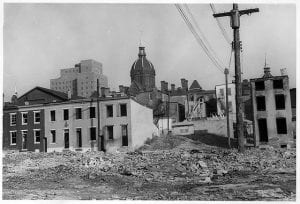
Slum clearance area with Johns Hopkins Hospital in the background. Photo courtesy of ubarchives via flickr, CC BY-NC-ND 2.0
New mapping data highlighted in an article in Chicago Magazine puts actual numbers behind the phrases “urban renewal” and “slum clearance.” These federal programs, which ran from the 1950s through the 1970s with the stated goal of revitalizing poorer, urban neighborhoods, are estimated to have displaced just over 1 million people over their lifetimes. The maps, created by the Digital Scholarship Lab at the University of Richmond focus on cities all over the country, but show that per capita, Chicago, Baltimore, and D.C. were the worst hit. Poor African American populations were affected most, but other income and ethnic groups were, as well, as large swaths of land promised for new housing were taken by commercial and industrial redevelopment. It is encouraging to see data behind these consequential aspects of 20th century policy (and the stories behind today’s main displacement catalyst, gentrification), as their aftershocks continue to be felt in individual displaced families as well as whole communities still attempting to recover, nearly forty years later.
When you think of unstable housing, you probably think about the constant moving from place to place or homelessness, but according to a recent paper by Megan Sandel, et. al, in Pediatrics, rent strain—a.k.a. being behind on rent—should also be on your list because it is the most prevalent form of housing instability. This is important because unstable housing has negative health impacts on caregivers and young children, but if health providers focus only on families that have moved multiple times in a year and those who have a history of homelessness, they’re missing out on a large portion of the low-income population that requires their services, too.
We’re giving the Trump administration’s plan to add working requirements to Medicaid two enthusiastic thumbs down. The administration is encouraging states to require that childless adults who are not disabled to work or take part in “community engagement activities” in order to get benefits, according to the New York Times, and it’s all under the guise of making people healthier. But it’s all nonsense. While studies on work requirements show that they “appear to have nudged some beneficiaries who were close to the poverty line above it, they do not appear to have meaningfully improved the long-term financial circumstances of eligible people, who were predominantly parents of young children with low levels of education.” So if it’s not helping long-term financial situations, how can these requirements make Medicaid recipients healthier?
Now this is a refreshing concept: A university program in Philly is training medical students to think like city planners and design healthier cities. The program, which is coming up in its third year, “focuses on design applications aimed at impacting real people’s health, from 3D printing that will help improve surgery to redesigning the physical space of hospitals. Most importantly, it’s about exploring the ways infrastructure, community, and the built environment can have a positive impact on health.” If we want to address the social determinants of health, now and in the future, we need more of this.
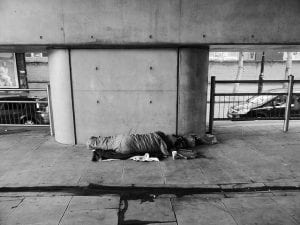
Photo by duncan c, via flickr, CC BY-NC 2.0
Point-in time counts took place all over the country this week. While we have shared the opinions over the years of professionals who assert that the counts are inherently inaccurate (especially for rural areas) because they focus on people on the streets, not necessarily families living in relatives’ homes, or people who are in constant danger of being evicted—we acknowledge that it is a start, as well as the effort of thousands of volunteers who take part in this very important activity. You cannot tackle a crisis until you know its full scope.


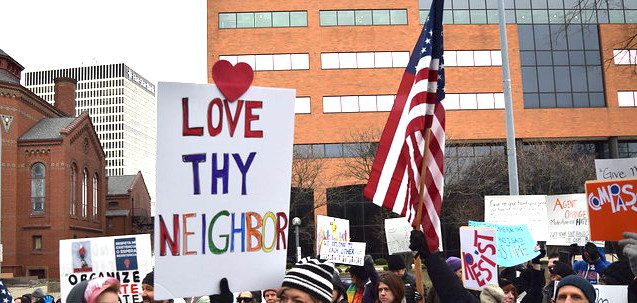

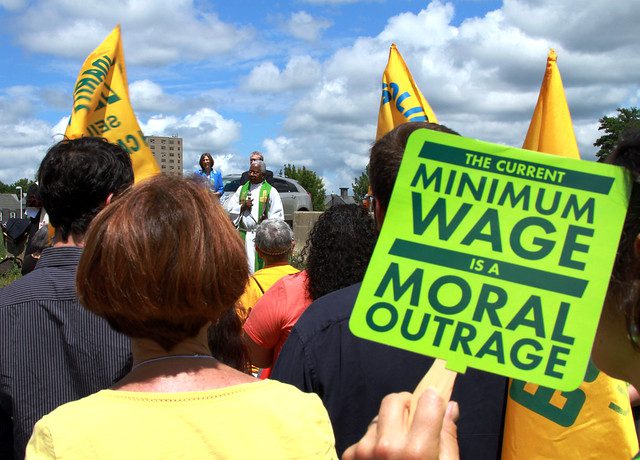
Comments